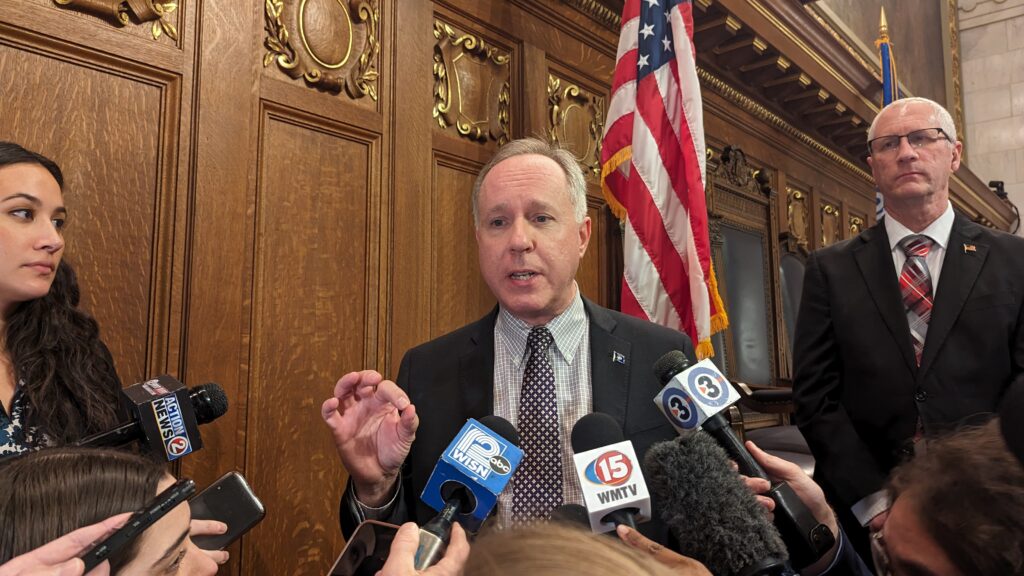Vos Recall Appears Short on Signatures
Which map of district should be used? Elections Commission says state Supreme Court must decide.

Assembly Speaker Robin Vos (R-Rochester) speaks to reporters following Gov. Tony Evers’ State of the State address in January. On Wednesday, the Wisconsin Elections Commission began its review of signatures filed by organizers of a campaign to recall Vos from his Assembly seat. (Baylor Spears | Wisconsin Examiner)
The attempted recall of Assembly Speaker Robin Vos by right-wing election conspiracy theorists appears to be short of the required amount of signatures to force a recall election this summer. Before the Wisconsin Elections Commission can make a ruling on the petition, however, it needs to figure out which district the signatures should come from.
To force a recall election, petitioners need to gather more signatures than 25% of the number of votes cast from that district in the prior gubernatorial election. Using the 63rd district that Vos has represented for nearly two decades, petitioners needed to gather more than 6,850 votes — a number that an initial WEC staff review found they failed to meet by around 900 signatures.
The holdup in the process is that in December, the Wisconsin Supreme Court enjoined the elections commission from using the maps that created the 63rd district because they were unconstitutional. But the new maps passed by the Legislature and signed by Gov. Tony Evers last month won’t go into effect until November.
Under the new maps, voters in the old 63rd district were split into new 33rd and 66th districts. The elections commission is unclear if the petition signatures need to come from the old 63rd district that elected Vos in 2022 or the two new districts. (Vos lives in the new 33rd district.)
Even then, the question remains whether voters in a potential recall should be limited to those living in the old 63rd district — on the map the Court declared was unconstitutional — or voters living in the two new districts.
If it’s the 63rd, the petitioners appear to be short of the required number of signatures. Even though the recall organizers submitted more than 10,000, many of the signatures come from voters outside of any of the three possible districts.
The recall group does have the right under state law to correct some signatures.
“This is unique in this sense. We have legislation and new maps that are not effective until November, but we have a Supreme Court decision that says these current maps were unconstitutional, and we’re enjoined from using them in any type of election,” Democratic Commissioner Mark Thomsen said at a WEC meeting Tuesday morning. “And so I think this is really important for the public to recognize that the staff is trying to figure out three possible scenarios, right? Three new districts that really don’t come into being until November. But that’s our guide for what may be constitutional, to determine whether we have sufficient numbers of signatures to even hold the recall election.”
The six members of the WEC requested Tuesday that the Department of Justice ask the state Supreme Court for clarity on the issue. The case in which the Court threw out the old maps remains open, despite a motion from legislative Republicans on Monday that it be dismissed.
Doug Poland, an attorney for the voting rights-focused law firm that brought the suit, says it is a strange situation in which the commission, and ultimately the Court, will need to decide what to do with elections during the eight-month gray period between now and when the new maps go into effect in November.
He says that question goes for any legislative elections during this period — the potential Vos recall, but also for any special elections for open seats, such as in the 4th Senate district left vacant after former Sen. Lena Taylor was appointed to a seat on the Milwaukee County Circuit Court.
On Tuesday, WEC staff declined to speculate on what the Court would decide, but said it’s possible a ruling could state that signatures have to come from the old 63rd while the recall election would be open to voters in one or both of the new districts. .
Poland, however, says it would make sense “intuitively” to allow the voters who put Vos in his seat to have a say in his possible recall.
As the issue of which district to use is decided, state law includes a number of requirements in the recall process.
Vos now has 10 days to issue a challenge to the filed signatures, after which the petitioners have five days to make a rebuttal and then two days to make a final statement. The commission then has 14 days to determine if there is a sufficient number of signatures.
If the commission finds that there aren’t enough valid signatures, the petitioners have five more days to correct certain flaws. Then the commission would meet again to determine if the signatures are sufficient and if they are, the election would be set for six weeks after that.
If two or more candidates from one party declare for the recall election, a primary election would be held on that date and the general election would be held four weeks after that.
All of those processes push a potential recall election into June.
Vos recall appears short on signatures as WEC seeks answers on district lines was originally published by Wisconsin Examiner.





















Glad to see them combating one another, instead of using their energy to move Wisconsin back to the Middle Ages.
Vos is just the latest tRump-Kisser to find out how easy it is to get on the wrong side of the Great Crazy Narcissist. It should have all the orange-nosed Trumpty Dumbties running scared.
Fun watching the snakes start devouring one another.